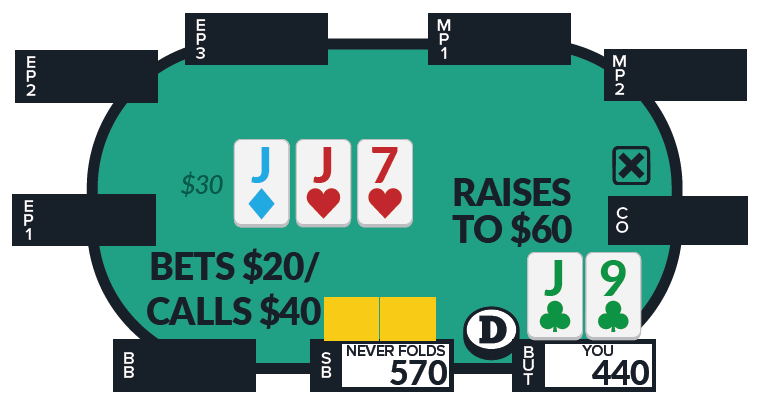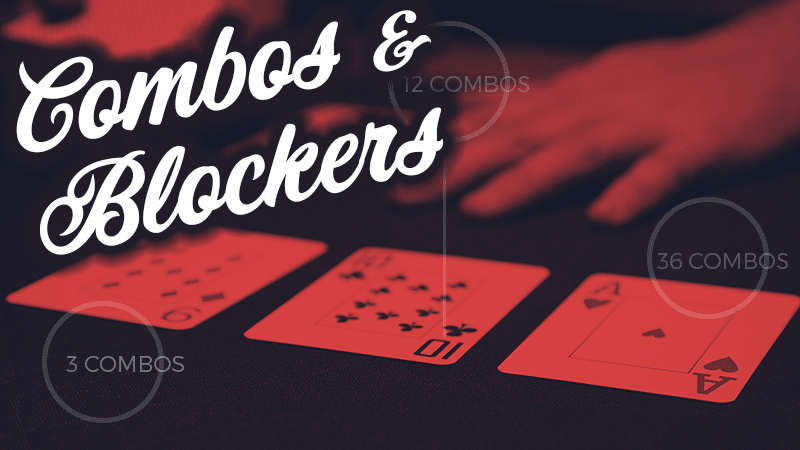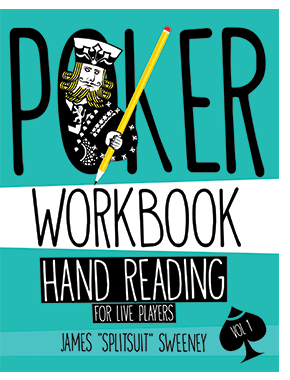Welcome to part 2 of dissecting hand 15 from the Hand Reading For Life Players Workbook: Volume 1. If you haven’t seen part one of this video series yet, please pause this and go watch that first. Otherwise, a lot of the things we’re going to talk about today just simply won’t make a tremendous amount of sense. So start with part 1 first.
If you’re here, exactly where you need to be, today we’re going to talk all about the flop range. We’re going to analyze the exact action the SB takes, exactly what range we think they did that with, and, of course, talk about tips and tricks that you can use to hand read better when you’re actually playing and making these decisions in real-time. So without further ado, let’s jump right in to it.
Just a reminder where we left off, preflop in hand 15 were playing $1/2 live. The cutoff opens at $10. We call on the button with J9s. The SB calls as well and we assign their range over on the template. By the way, remember, if you want to download this template, you can do so for free at www.splitsuit.com/templates. It’s a name your own price product. Zero dollars works and tips are also accepted and appreciated.
Without further ado, let’s take that range and start rocking and rolling. So there are three players to a $30 dollar flop and the SB decides to lead out for $20. So when building a donking range, remember a donk is a lead. It’s just simply betting into the preflop aggressor. Cutoff was the preflop aggressor. SB bet into them, so it’s a lead or a donk bet. It’s all the same thing.

When building this kind of range, think about the hands that they would lead with. Would they check-raise or would they lead with certain hands? So the prompting questions down below are do you think that they would lead or check-raise with Jx, flush draws, 88 or 7x kind of hands?
Let’s start breaking it down, open up Flopzilla, and have some fun. Start by plugging in the board into Flopzilla. So jack of diamonds, jack of hearts, seven of hearts. Awesome. And let’s start answering these questions. Again, these prompting questions are just here to get us starting to think about, okay, what does this range realistically look like? Can we delete anything? Can we add anything? Can we just weight something? And then go forward from there.
Starting with Jx, do we think that the SB is likely to lead out with Jx or check-raise with it or possibly even check-call instead? Then I think leading out makes a lot of sense. Again, if we just hover over it and look at what they could possibly have with it, yes, they can make Jx a bunch of different ways. But this is also a scenario where there simply aren’t too many Jx combinations available. We do have the jack of clubs in our hands, so there’s only one possible jack left in there and there just aren’t a ton of these.
And I do think that they would check-raise with it sometimes, so I’m going to go in here to weight this. If you’ve never done this before, in Flopzilla, you hover over the hand category, you right click it, and then you can apply that filter. I’m just going to apply, say, 60% of the time, they’re going to lead with it. The other percentage of the time, I think they’re going to either check-raise or check-call. Most likely check-raise given this type of player type.
That’s first and foremost. Next let’s focus on flush draws. So do I think they’re likely to lead here with flush draws? Well, let’s just hover over and see what they look like. I think that’s pretty realistic. A lot of these flush draws are either going to have some sort of over card attached with it or some sort of straight draw, like a T9 or T8. So, yeah, I’m actually going to leave all the flush draws in.
The what about these medium-ish, strong-ish pairs? I’m going to put heavy emphasis on -ish in this scenario. So preflop, we did think that they were more likely to call with things like 88s. We didn’t think they were going to 3bet it. Again, if you haven’t seen part 1, stop and go watch that first. And do we think they’re going to lead with that kind of stuff? So things like 8s, 9s, Ts, 7x kind of stuff, which is kind of like these middling pairs.
Well, let’s look at them. I think that there’s a decent chance that they lead with these kind of hands. I don’t think that this kind of person is going to know what to do with 100% of them. I think that there’s a pretty decent chance that they lead sometimes and they check-call sometimes. So I’m going to go in here and give a 50% filter. I think that’s probably pretty fair. And then just accept that and we’re good to go.
I don’t think they’re going to lead with total garbage. I don’t think they’re going to lead with naked A high. I don’t think they’re going to lead with total nonsense. I think when they lead in this kind of situation, they’re looking at something that connects with this board in some way. It could be a strong Jx. It could just be a medium pair. It could be a draw. But I don’t think you’re going to see the SB leading out with total nonsense like K6o or anything like that.
I think this is a pretty fair assumption going forward. And just for the record, if you’re not really used to Flopzilla, these are the kind of things you need to keep in mind. One is this filtering thing. Again, if you right click the hand category, you go in, make your weight adjustments and go forward from there.
Number 2, once you’ve selected all of the hands that you think, okay, this is what I think they’re continuing with like this in this exact situation, select all those hands, get them in, and then go down here and turn this to green.
Notice now that it’s only going to show in the matrix on the left all the hands that they’re going to be continuing with. All the hands that we thought they were going to lead with are now involved in this. Then from here, remember last time we talked about that trick, Control/Alt/T, this is going to give us the entire range, exported, so that we can just paste it in here and we’re good to go. This gives us that for the future. And then we can just plug in the rest stuff. Percentage of previous range, we have 19.3%. Perfect. If we hit tab in Flopzilla, that brings us over to combo mode. Then we can see exactly where we are. So we’re at 138.
Normally, we would be done here. But in this exact situation, the action is not over with, so we have to continue going forward.
Continuing along with the action, in this situation, the cutoff folds to that original $20 bet. We raise to $60 and then the SB decides to call. Again, let’s continue this hand reading process and break it down and take this range that we built for the leading range and think about what is going to continue after we raise to $60 and what continues specifically by calling?
If we start with the prompting questions in the workbook, think about the hands that the SB would re-raise with here. Are they more likely to flat or re-raise with Jx, flush draws or total air? Well, we didn’t think there was too much air in that donk game range in the first place, so we’re not too concerned about that. But we’re very concerned about would they flat our $60 raise with things like Jx or things like flush draws or that kind of stuff?
Now, again, I’m going to make some assumptions and I’m going to carry these assumptions all the way through the hand. If you disagree with them, that’s totally okay. When you work through this hand on your own or when you’re in real-time and you’re making your own assessments and judgments, then, yes, you say, “Okay, this is exactly what I think in this scenario.”
Personally, if I’m looking at things like Jx and the small blind has it, do I think they’re more likely to 3bet or call here? And to be honest, I think they’re more likely to come over the top. So I think that’s gone once they just decide to flat here. I think when they look at a board like this, they see a flush draw, they see a gut shot on board. I think you’re going to see the SB get very, very active with 3 of a kind.
Full houses, maybe they occasionally have that, but I’m honestly going to reduce this down to probably half. I’m just going to go from there. What about middle pair? Well, I don’t think they’re going to 3bet it. I think they’re pretty likely just to flat it in this scenario. Again, they’re described as someone who never folds. I don’t think they’re magically going to find the fold button here for only $40 more. I think they’re calling pretty much all of these 100% of the time.
The same thing with 8s, 9s and Ts. I don’t think they’re going to fold them, but I also don’t think they’re going to 3bet them. So that’s kind of where I’m at in this scenario. The other most important piece here really comes down to the flush draws. Again, are they going to play them aggressively by coming over the top here or are they going to flat them more often than not?
What I’m going to do here is I’m going to get into the flush draws and I’m going to get rid of a couple of them. So I’m going to get rid of these big ones. I think it’s pretty fair to say that that’s probably the case. So I’m just going to get rid of those. We’re going to probably get rid of the double over-card ones: AQ, KQ. I think if they had that, they’re more likely to come over the top themselves. Everything else I think is fair enough to say that they probably flat more often than not.
Now we’re back to the 41 combos. I think this is probably pretty fair.
The major reason why we did this is, one, we want to be very, very precise on the range that’s going to be continuing on to turns and rivers. And notice that when we build this, what does that range primarily look like? A couple of combos of very, very big hands, and a lot of combos of not so big hands.

Take the new Combos & Blockers quiz and prove that you have this concept mastered. Knowing how to quickly count combos is a vital skill that you need when hand reading and applying well-timed bluffs vs any opponent. Challenge yourself today with this quick 10-question test…
Obviously, we’re annihilating this range in this scenario. They can have middle pairs, we crush. They can have pocket pairs below top there, we crush. They can have flush draws, we currently crush. So we are in a really, really good scenario here, so I’m going to do this. I’m going to put a hyphen between the two numbers. That way we know that, okay, we started the lead with 138 and we are now here with 116. I’m going to hit tab mode to get over to the percentage form and, again, here we are 16.
I am going to do one more Control/At/T, copy that and we’re going to paste it in. And, again, the major reason why we do this is so if we want to play this hand later down the line, we can just put it in, mash, rock and roll, and go forward from there.
Again, this is a little bit lengthy. This is a little bit tiresome when you have to go through piece by piece of that range and really analyze it, but look how precise this range is now. And look at what we can do with this information when it comes to future line creation, when it comes to choosing a bet size on turns and rivers. If we end up facing a bet on future streets, what is that bet done with and how can we react accordingly?
We can only do this by analyzing the hand step-by-step, street-by-street, action-by-action, and getting really, really technical. Now, of course, in real-time, you’re not going to be able to pull out Flopzilla. You’re not going to be able to pull out your template and start hacking away at it and saying, “Okay, well, he’s continuing this percentage of the time or that percentage of the time.” That’s not the case in real-time.
The whole point is to practice this stuff enough off table that it becomes ingrained, it becomes second nature to break down hand ranges in this process. It becomes a little bit easier to estimate number of combos or percentage of previous range when it comes to making real-time decisions and real-time assessments. So work through this stuff and continue with it.

